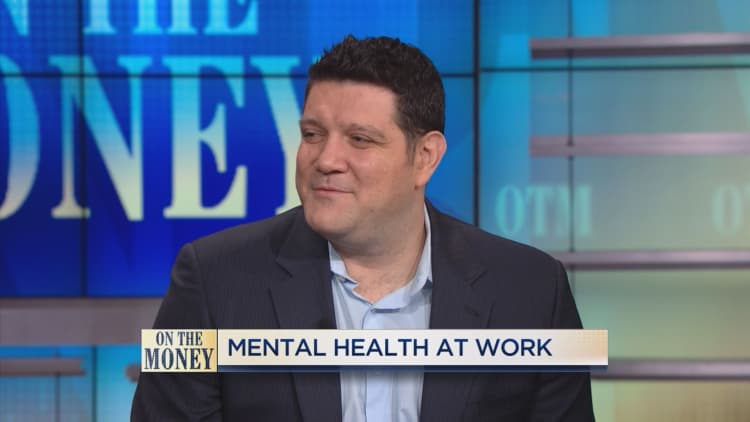Millennials, born between 1981 and 1996, are the largest generation in today's U.S. workforce. And while they may be revolutionizing and redefining the way we work — with more than 75% of them eschewing a typical 9-to-5 workday for a more flexible and fluid environment — this flexibility comes at a cost: a harried, hurried and overworked mass who is plugged in 24/7, pushing to work harder and better.
Indeed, a whopping 77% of those who responded to a 2018 study by Deloitte reported experiencing employee burnout at their current job. Burnout recently has been redefined by the World Health Organization as a "syndrome" linked to "chronic workplace stress that has not been successfully managed."
According to the Centers for Disease Control and Prevention, stress can negatively affect job performance and productivity, engagement with one's work, communication with co-workers and physical capability and daily functioning.
While WHO does not classify the problem as a medical condition and rather an "occupational phenomenon," it does conclude that burnout is a factor that influences health status and gives motive to contact health services outside of illnesses or health conditions.
"The concept of separation between work and free time doesn't exist for a lot of us," says one millennial Manhattan attorney who did not wish to be identified. He says he spends three-plus hours round-trip commuting to his job from a Connecticut suburb.
"Thanks to technology, we're expected to be responsive regardless of where we are or what we're doing," he says, adding that "disconnecting only leads to feelings of guilt and anxiety."
Using teletherapy to cope
Ironically, one of the culprits behind millennial burnout — technology — can also be utilized to extinguish burnout's flame.
Teletherapy, a form of telehealth, offers online counseling with licensed therapists via phone, webcam, email or text message. Also known as telepsychology, telemental health or telepractice, this service has been around for more than 20 years, originally utilized by the military to treat veterans and serve patients in rural areas. And now the convenient way to access mental health is catching on with millennials.
"Being digital natives, millennials are naturally drawn to apps and online services," says clinical psychologist Sonya Bruner, Ph.D., former clinical director of the largest online counseling platform, BetterHelp.com, where 23- to 28-year-olds make up 60% of its total users. In addition to BetterHelp.com, more than a dozen sites and apps launched in the last several years, according to the American Psychological Association, among them TalkSpace, 7 Cups of Tea, American Well, Breakthrough and Lantern. Packages vary; some charge weekly fees starting at $32, while others bill monthly at rates ranging from $49 to $150 per month.
[Teletherapy is] the new frontier in mental health counseling. It's amazing how it's caught on: It's private. It's convenient. It's comfortable for both the therapist and client. And it eliminates the stress of traffic and time.Goali Saedi Boccimental health therapist
There are also a growing number of mental health therapists, like Goali Saedi Bocci, Ph.D., of Portland, Oregon, who treat their patients remotely. "I treat my patients 100% online," she says, adding that teletherapy is emerging as the "new frontier in mental health counseling. It's amazing how it's caught on: It's private. It's convenient. It's comfortable for both the therapist and client. And it eliminates the stress of traffic and time."
Teletherapy vs. face-to-face care
According to CTel, a legal and regulatory telehealth organization, many millennials embrace the practice of teletherapy. A recent survey of more than 3,500 insured adults throughout the U.S. found that millennials were "far more likely to express an interest in telemedicine compared to prior generations."
Among its fans, some who have posted reviews of their experiences on teletherapy websites are those who say, "I'm a ten-times better version of myself;" "I feel like I can talk in a way I can't in any other part of my life;" and "My therapist always responds quickly and provides insight and direction."
Research says that teletherapy is not only "an acceptable alternative" to traditional face-to-face care, but it can be just as effective. Because millennials are used to and comfortable with communicating via mobile device, it appears to be easier for them to open up this way, especially when sharing more personal information. Here are some of the other benefits:
- It's available anytime and anywhere, eliminating many hurdles to care, like travel time and access.
- It's usually less expensive than face-to-face counseling.
- It allows for support between visits.
- It may encourage a person to seek care who is otherwise hesitant to explore mental health therapy.
Employers are catching on
Millennials are not alone in embracing teletherapy; as health-care costs skyrocket and employers seek alternatives to ensuring their employees' mental health, many companies are in favor, too.
Forty-seven percent of Cisco's workforce is comprised of employees born between 1980 and 2000. The company embraces a "conscious culture" and recognizes the importance of addressing employee stress and burnout. As Ted Kezios, vice president of human resource global benefits explains: "We want our employees to recognize that we all have mental health, and offer personalized solutions to all our employees that address the spectrum of well-being. Likewise, we encourage our managers to listen to their employees with compassion and empathy."
Weekly "check-ins" allow ongoing communication between employees and their managers in an atmosphere of safety and trust: "Employees are encouraged to reflect back on the prior week and report on what they loathed and on what they loved."
So it's no wonder that Cisco, who is also conscious of workload's close relation to burnout, offers teletherapy to its employees to help them deal with work-life stressors and personal issues that might stand in the way of their performance. Last year they launched a program with Vida, a digital coaching platform with one-on-one coaching, offering guidance on nutrition, exercise, sleep issues and stress management. Additionally, the company offers other mental health perks, like teletherapy via some of its onsite health centers (where employees can connect virtually with a therapist after an initial in-person consultation); an online five-session mindfulness course and countless other online mental health resources.

But therapists must do their due diligence, since rules and regulations for providing teletherapy vary by state. Insurance coverage, too, differs for users of teletherapy, depending on their provider. Some online services will accept specific independent health plans as well as employee assistance programs and behavioral health benefits, while others advise potential clients to check with their individual health insurance plans.
Still, some are still not sold on the concept of online therapy — among them the 34-year-old Manhattan attorney, who says that although his is a generation used to getting satisfaction from their mobile phones, he wouldn't use a teletherapy service. "In order to really focus on a conversation, I need to be physically present; I feel like I'd be distracted by yet another function completed via technology."
Jen Rice, a 23-year-old administrative assistant for a major entertainment company, tried a few sessions through the app Teledoc but didn't continue. "I think a huge part of therapy is the in-person interaction and ability to talk face-to-face," she says.
Still, with time being extremely limited and a precious resource for millennials, teletherapy remains a viable, valuable and popular way for them to embrace and combine their flexibility and tech-savviness with a good cause: their mental health.
For more on tech, transformation and the future of work, join CNBC at the @ Work: People + Machines Summit in San Francisco on Nov. 4. Leaders from Dropbox, Sas, McKinsey and more will teach us how to balance the needs of today with the possibilities of tomorrow, and the winning strategies to compete.





